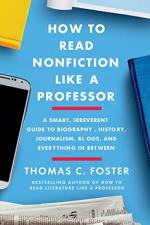
|
| Name: _________________________ | Period: ___________________ |
This quiz consists of 5 multiple choice and 5 short answer questions through Section 5: Chapter 16, "Social (Media) Disease" through "Conclusion".
Multiple Choice Questions
1. In "Interrogating the Text," Foster says that readers should beware of ad hominem arguments. What he means is that readers should be suspicious when writers do what?
(a) Portray the opposition argument as much weaker than it actually is.
(b) Contend that because something is new it must be better or more correct.
(c) Appeal to emotion rather than to logic.
(d) Attack the people making arguments instead of the arguments themselves.
2. In Chapter 9, "Living the News," how does Foster apply the idea of "free indirect speech" to New Journalism?
(a) He uses it to compare New Journalism with immersive journalism.
(b) He uses it to explain how Thompson narrates his own thoughts.
(c) He uses it to label Wolfe's attempt to recreate the inner lives of his subjects.
(d) He uses it to contrast New Journalism with fiction.
3. In Chapter 14, "The Universe of Ideas/Ideas of the Universe," what does Foster seem to admire most about Neil deGrasse Tyson's writing?
(a) That he finds a way to communicate very abstract and unfamiliar ideas.
(b) That he is a witty and engaging writer.
(c) That he is one of the few scientists who can write about many fields of science.
(d) That he confines he writing to easily understood concepts.
4. In Chapter 13, "On the Stump," Foster alludes to Peyton Place because he is implying that Fire and Fury is essentially what?
(a) A comic masterpiece.
(b) A mediocre melodrama.
(c) A thought-provoking fiction.
(d) A dry and academic piece of scholarship.
5. In Chapter 13, "On the Stump," what criticism does Foster level at Comey's book A Higher Loyalty?
(a) The use of hearsay.
(b) The attribution of sources.
(c) The omniscient narrative style.
(d) The logic of two key passages is suspect.
Short Answer Questions
1. In Chapter 8, "Bringing the News," what reason does Foster give for journalists generally being proved correct despite public mistrust?
2. In Chapter 9, "Living the News," what historical era does Foster tie New Journalism to?
3. In Chapter 17, "The Criminal Element," what does Foster suggest that the ordinary reader do to guard against bad data?
4. In Chapter 13, "On the Stump," what does Foster say that Wolff mostly wrote about before writing Fire and Fury?
5. In Chapter 4, "The Parts You Don't Read," what is a piece of information that Foster says we can infer from the notes?
|
This section contains 433 words (approx. 2 pages at 300 words per page) |

|




